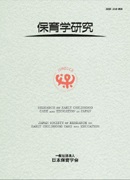Volume 46, Issue 2
Special Topics: Cooperation among Childcare Workers
Displaying 1-28 of 28 articles from this issue
- |<
- <
- 1
- >
- >|
Foreword
-
2008Volume 46Issue 2 Pages 139-
Published: December 25, 2008
Released on J-STAGE: August 04, 2017
Download PDF (125K)
Part I Article on Special Topic: Cooperation among Childcare Workers
-
2008Volume 46Issue 2 Pages 144-147
Published: December 25, 2008
Released on J-STAGE: August 04, 2017
Download PDF (492K)
Articles
-
2008Volume 46Issue 2 Pages 148-157
Published: December 25, 2008
Released on J-STAGE: August 04, 2017
Download PDF (1028K) -
2008Volume 46Issue 2 Pages 158-168
Published: December 25, 2008
Released on J-STAGE: August 04, 2017
Download PDF (1076K)
Invited Articles
-
2008Volume 46Issue 2 Pages 169-178
Published: December 25, 2008
Released on J-STAGE: August 04, 2017
Download PDF (979K) -
2008Volume 46Issue 2 Pages 179-188
Published: December 25, 2008
Released on J-STAGE: August 04, 2017
Download PDF (1052K) -
2008Volume 46Issue 2 Pages 189-200
Published: December 25, 2008
Released on J-STAGE: August 04, 2017
Download PDF (1261K) -
2008Volume 46Issue 2 Pages 201-211
Published: December 25, 2008
Released on J-STAGE: August 04, 2017
Download PDF (1127K)
Part II Article on Free Topic
Articles
-
2008Volume 46Issue 2 Pages 214-224
Published: December 25, 2008
Released on J-STAGE: August 04, 2017
Download PDF (1114K) -
2008Volume 46Issue 2 Pages 225-234
Published: December 25, 2008
Released on J-STAGE: August 04, 2017
Download PDF (1021K) -
2008Volume 46Issue 2 Pages 235-244
Published: December 25, 2008
Released on J-STAGE: August 04, 2017
Download PDF (1011K) -
2008Volume 46Issue 2 Pages 245-256
Published: December 25, 2008
Released on J-STAGE: August 04, 2017
Download PDF (1216K) -
2008Volume 46Issue 2 Pages 257-266
Published: December 25, 2008
Released on J-STAGE: August 04, 2017
Download PDF (1072K) -
2008Volume 46Issue 2 Pages 267-276
Published: December 25, 2008
Released on J-STAGE: August 04, 2017
Download PDF (1125K) -
2008Volume 46Issue 2 Pages 277-288
Published: December 25, 2008
Released on J-STAGE: August 04, 2017
Download PDF (1212K) -
2008Volume 46Issue 2 Pages 289-298
Published: December 25, 2008
Released on J-STAGE: August 04, 2017
Download PDF (1134K)
Date
-
2008Volume 46Issue 2 Pages 299-309
Published: December 25, 2008
Released on J-STAGE: August 04, 2017
Download PDF (1370K)
Part III Committee Report
Report on the 8th Symposium Planned by the International Exchange Committee
-
2008Volume 46Issue 2 Pages 312-321
Published: December 25, 2008
Released on J-STAGE: August 04, 2017
Download PDF (1093K)
Assignment Reports
-
2008Volume 46Issue 2 Pages 322-323
Published: December 25, 2008
Released on J-STAGE: August 04, 2017
Download PDF (200K) -
2008Volume 46Issue 2 Pages 324-334
Published: December 25, 2008
Released on J-STAGE: August 04, 2017
Download PDF (1101K)
Part IV A Step in Early Childhood Care and Education (2)
-
2008Volume 46Issue 2 Pages 200-210
Published: December 25, 2008
Released on J-STAGE: August 04, 2017
Download PDF (1347K) -
2008Volume 46Issue 2 Pages 347-357
Published: December 25, 2008
Released on J-STAGE: August 04, 2017
Download PDF (1128K) -
2008Volume 46Issue 2 Pages 358-
Published: December 25, 2008
Released on J-STAGE: August 04, 2017
Download PDF (158K) -
2008Volume 46Issue 2 Pages 359-
Published: December 25, 2008
Released on J-STAGE: August 04, 2017
Download PDF (114K) -
2008Volume 46Issue 2 Pages 360-372
Published: December 25, 2008
Released on J-STAGE: August 04, 2017
Download PDF (1417K)
Contents
-
2008Volume 46Issue 2 Pages 373-375
Published: December 25, 2008
Released on J-STAGE: August 04, 2017
Download PDF (105K)
Afterword
-
2008Volume 46Issue 2 Pages 376-
Published: December 25, 2008
Released on J-STAGE: August 04, 2017
Download PDF (74K)
publication data
-
2008Volume 46Issue 2 Pages App3-
Published: December 25, 2008
Released on J-STAGE: August 04, 2017
Download PDF (42K)
- |<
- <
- 1
- >
- >|
